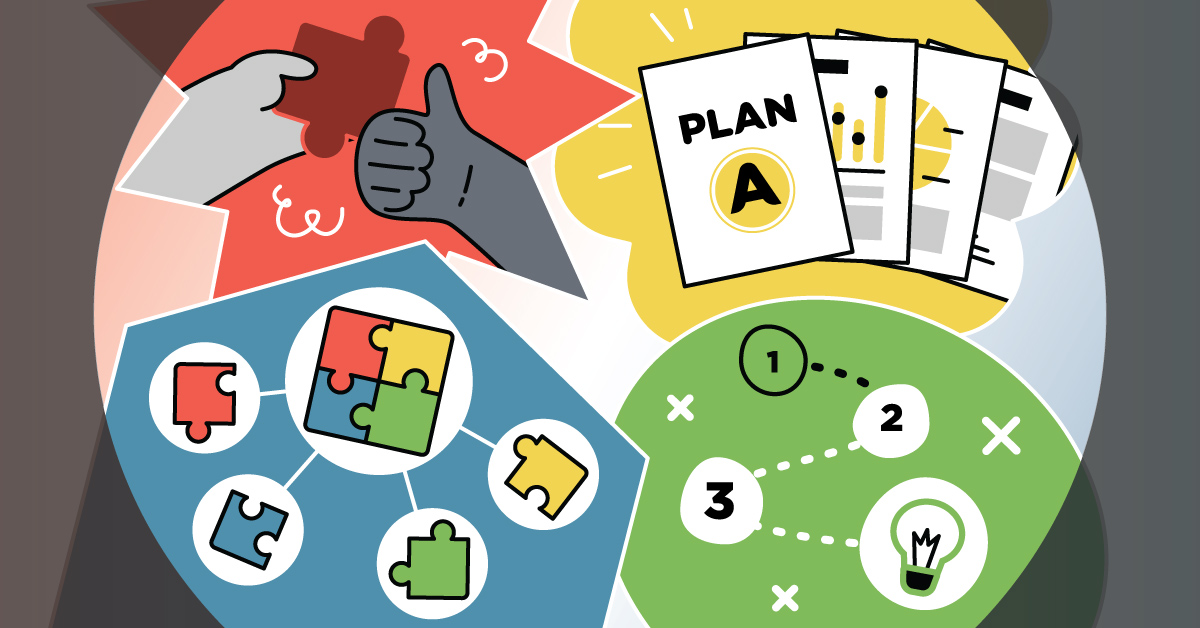
We’re at the beginning of the year, a time when it’s common to examine your behavior, pick apart your habits, and try to set some personal goals. With that in mind, remember that it’s only human to make mistakes and cause conflict with your peers. This is especially likely if you’re ‘in the red’ or emotionally compromised in any way.
The great news is that awareness is the first step to overcoming these hurdles! Just by reading this article, you’re giving yourself a head start to correcting behavior that will portray you in a negative light to those around you. Here are behavioral blindspots according to primary DISC type, and how to account for them.
The High D Behavior Blindspot: Pushy Under Pressure

Direct people are ambitious, decisive, competitive, confident, positive, and leaders. Their straightforward ‘get it done’ approach can help their team find a fast pace, but it might not help them stay productive.
Under pressure or without self-awareness, Direct people come across as aggressive and insensitive. Their fast-paced nature will exhaust other team members and their high Dominance can cause them to skip small talk, which makes them appear demanding. While Direct people believe they are just telling it like it is, this can come across as arrogance.
The Direct Correction: Take Time to Get Personal
The good news is that Direct people are people-oriented. They genuinely enjoy connecting with others; they just generally prefer to do it on their own terms.
Take the right approach and focus on your peers! Whenever you feel the crunch of pressure and sense your direct nature wanting to take over, redirect it to the correct channels. Take the time to ask, “How can I help in this situation?” or “What are you looking for from me right now: support or problem-solving?
By getting specific, you can help others guide you to what they need and then you can ensure you are focusing your intensity in a productive way. The other person feels heard and you get to take action! That’s a win-win for Direct behavioral styles.
The Low D Behavior Blindspot: Passive Turned Aggressive
Reflective people are cooperative, low-key, modest, and mild. They tend to engage people by being agreeable and outcome-focused and prefer clear, precise, and thorough communication.
People with a low D in DISC loathe conflict and will do their best to avoid it, but that can come at a cost. Their reluctance to tell it like it is and bring up issues in their team can cause confusion down the road.
Instead of handling an issue when it first comes up, when under pressure, Reflective communicators might resort to using off-hand comments and passive-aggressiveness to try to get their point across. While this might feel like a low-conflict solution, it will just make their more direct team members frustrated.
The Reflective Correction: Express Yourself, Your Way
Conflict can be difficult but it doesn’t need to be! Even if you have a low Dominance score, you can find a way to communicate clearly and express yourself, even in a tense situation.
A great way to do this is to purposefully choose a method of communication that you feel comfortable using. For example, if you get flustered in the moment, try writing out your perspective and sending it in an email or keep the notes nearby when speaking in person. If you have a hard time reading tone over text, arrange for a face-to-face conversation to get the clarity you need.
It might feel difficult at the time, but keep this in mind; getting direct to resolve conflict will prevent more conflict in the future. You’re doing your future self a favor! Read more about Dominance, Direct communicators and Reflective communicators here.
Read more about Dominance, Direct communicators and Reflective communicators here.
The High I Behavior Blindspot: Assuming Enthusiasm

Outgoing communicators are enthusiastic, outgoing, charming, inspiring, and persuasive. They are people-oriented, not task-oriented, and are their happiest when interacting with others.
People with a high I usually take a high energy approach to every situation which can cause communication problems with their more internal peers. If they are not getting a response that matches their enthusiasm from their teammates, they are likely to become discouraged and disengage.
The problem here is that Outgoing people want others to have a high level of buy-in to their ideas and processes immediately, while other types of communicators need hard data to back up decisions.
The Outgoing Solution: Back-Up For Buy-In
It’s time to do some work upfront to save yourself hesitancy down the road— the good news is that you’re naturally persuasive! Turn your efforts towards a little research and find out what your peers want to know to help them make decisions.
Do they want visualized data to better understand? Would a testimonial from a similar situation help them understand your point? How can you best communicate your desires and decisions?
When you make sure that you can back yourself up, you create a pool of social proof to draw from. Every time you put that work in, you prove that you know your stuff and you’re someone worth trusting.
The Low I Behavior Blindspot: Assuming Intent
Reserved communicators are factual, logical, discerning, and perceptive. They are great listeners and have rich internal worlds, but this internalization can cut them off from others and lead to misunderstandings and conflict.
Low Is tend to withdraw in tense situations which can cause unnecessary tension with their more outgoing teammates. Their natural skepticism can help them find problems in processes to make them more productive, but it can result in not trusting others and suspecting manipulation when someone is being friendly. When that apprehension is turned towards people, not processes, distrust will build on a team.
The Reserved Solution: Presume the Best, Prepare for the Worst
Analytical thinking and preparing for all kinds of problems is a strength in a team but you need to remember that the worst-case scenario is not always reality. Just because you want to be prepared doesn’t mean you should write people off.
When you feel yourself getting suspicious of the behavior of other people, take a step back and consider their point of view. (Using their DISC graphs to do this will be immensely helpful.)
What are some of the reasons they could be connecting with you? Are they lonely? Are they trying to use your expertise to make a more informed decision? It can be difficult to think the best of people when you’re accustomed to thinking the worst, but it will transform your relationships with your teammates.
Read more about Influence, Outgoing communicators and Reserved communicators here.
The High S Behavior Blindspot: Putting It All On Pause

Steady communicators are considerate, thoughtful, good-natured, and dependable. They enjoy supporting others on a team, and thrive in structured environments.
However, their preference for a slow pace can become a hangup in their productivity. Under pressure, High Ss tend to slow down instead of responding with agility and will panic when a faster pace is necessary. This can lead to them dragging their feet when it comes to finishing projects and hesitating to ask for clarification or a heavier workload when they’re capable of more.
The Steady Solution: Get Clarity and Go!
Overcome this blindspot by trusting in the processes established by your team! That doesn’t mean you need to accept all direction at face value; make sure to ask as many questions as you need to feel confident in your work. Your ability to ground a project is valuable, but you need to remember that your teammates’ ability to pick up the pace is as well.
This clarity can be achieved by asking for a project brief or a communal organizing tool like Basecamp or Trello. Make sure that each step of the process is accounted for and, once you do that, it’s time to get to work! Don’t be afraid to jump into the project when the time comes.
The Low S Behavior Blindspot: Starting What You Can’t Finish
Dynamic communicators are flexible, active, energetic, and ready for anything. They love a fast paced environment and thrive under changing circumstances, but this break-neck speed can cause problems on a team.
Low Ss have a tendency to assume everyone can follow their logic when making decisions. If things worked at their preferred pace, it would be easy for the workplace to dissolve into an ‘every man for himself’ mentality.
The Dynamic Solution: Show Your Work
It might sound overly simple, but that’s the best kind of solution; make sure to demonstrate your process as your work so others can track your work! This can be achieved by simply writing down your logic and communicating it ahead of time when it comes to decision making, annotating your work with explanations, or asking a slower paced team member to review your work and ask questions when they get confused.
Remember that you’re not the only one who needs to understand your work! Everyone on your team will benefit from creating clarity and this will help your team members invest in your ideas in the future, since you’ve proven you know what you’re doing. Create that trust.
Read more about Steadiness, Steady communicators and Dynamic communicators here.
The High C Behavior Blindspot: Policy Over People

Precise communicators are thorough, careful, analytical, and well-informed. They tend to stick to the facts and avoid feelings when making decisions, and like basing those decisions on hard data, not instinct.
High Cs usually double down under pressure which can lead to a communication breakdown. They can come across as cold and impersonal; they also might not see any reason to change this approach if they believe it’s the right one. That unwillingness to consider feedback will influence the way others perceive them and work with them.
The Precise Solution: Analyze Another Perspective
Bring your analytical mind and apply it when it comes to understanding others! Look at the points of view of others through the lens of their behavior, motivation, and EQ. This will give you a measurable set of data to understand and use to understand your peers.
Once you’ve worked to understand their points of view, adjust your behavior to complement their behavioral style! You’re not doing an entire overhaul of your actions, just tweaking your communication to better suit their needs. A little consideration goes a long way when it comes to realizing an optimized outcome.
The Low C Behavior Blindspot: Whimsy Over Workmanship
Pioneering people are independent, unconventional, and outspoken. They enjoy taking the path less traveled and thinking outside the box to solve problems and handle work. This behavior can lead to visionary results and immense frustration from more structured teammates.
While Low Cs are open to throwing out plans and taking a new approach the second a plan doesn’t work. Pioneering communicators have a tendency to be flighty and inconsistent under pressure. Their rules-oriented team members will get frustrated fast with their loose approach.
The Pioneering Correction: Make the Big Picture Bite-Sized
Get your head out of the clouds (just a little bit!) and make your visionary approach actionable. Dream as big as you want, then break down that ideal outcome into tangible steps.
You’ll get to imagine an ideal outcome, and then you get to prove to your peers that you can deliver. Once you do so, you’ll get future buy-in and support for your next big idea.
Read more about Compliance, Precise communicators and Pioneering communicators here.
Conquering Behavioral Blindspots With DISC
Understanding the ‘how’ behind your ‘why’ can get complicated. That’s exactly why tools like DISC are so valuable in the workplace. By raising your awareness about your tendencies and behavior, you can avoid blindspots, increase productivity, and give your engagement a kickstart.
If you want to unlock your potential with DISC or other behavioral assessment tools TTI SI can help! Contact us here to get started.




